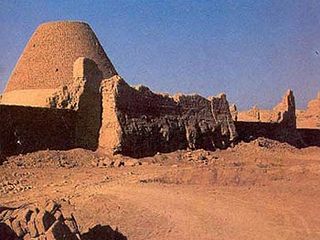
Known as the "Underground Museum" and widely valued by Chinese and foreign archaeologists and historians, to the northwest of the Gaochang Ruins lies the Astana Graves (Asitana Gumuqun), where the dead of Gaochang were buried. Astana means "capital" in Uygur and Karakhoja is the name of a legendary hero of the ancient Uygur Kingdom who removed the evils from the people by killing a vicious dragon. They are now the names of two local villages. The ancient tombs are clearly zoned according to families and castes with natural stones.
The Astana-Karakhoja Ancient Tombs are part of the Underground Museum of Turpan and the Living Archives of Gaochang. Astana means capital in Uigur; Karakhoja was a Uigur hero who protected his people from a vicious dragon.
The burial area is large and stretches 5 km from east to west and 2 km from north to south. Unfortunately, today only three of the tombs are open to tourists, and each of these is approached by a short flight of steps which leads down to the burial chamber about 6km below ground level. Besides dried-up corpses, there are murals depicting figures, birds and flowers on display in the three tombs.
The typical Astana tomb has a short flight of steps leading down into the tomb. The burial chambers of the tombs generally have low ceilings (about 2 meters high) and a total area of about 4 square meters. The two of the three graves open to the public have paintings of either the deceased or of birds, while the third has two well-preserved corpses on display!!
The tombs were the public cemetery of the ancient Gaochang residents, both aristocrats and commoners. Among the excavated 456 tombs, the Gaochang king's has not been found. So buried in these tombs are nobles, officials and others from the period beginning in the Western Jin and ending in the middle of the Tang Dynasty. Curiously, the tomb of King Gaochang is found nowhere in the group of tombs, but the renowned general Zhang Xiong of the Qushi Gaochang Kingdom was buried here with his wife and son Zhang Huaiji. Almost all of the corpses in the more than 500 tombs have not rotted; instead they have become dried-up bodies, a phenomenon more unusual than the mummies found in the pyramids of Egypt. Most of the dried-up bodies are complete and intact.
Thanks to the dry and hot climate, many paintings, earthen figurines and thousands of other unearthed cultural relics are well-preserved and as colorful as new ones. The unearthed boiled dumplings of the Tang Dynasty are the same shape as those of today and the stuffing of the dumplings is still fresh. Furthermore, on a bail of horse fodder are written the words "Judge Cen" and "Minister Feng". Judge Cen is the famous frontier poet Cen Shen of the Tang Dynasty and Minister Feng is Feng Changqing, the governor of Beiting Prefecture of the Tang Dynasty. Most of those buried here were people of the Han nationality, but also some minority nationalities, such as the Cheshi, Hun, Di, Xianbei, Gaoche, and Zhaowujiuxing.
The deceased typically rest their heads on a cloth pillow and have their faces covered with a cloth. They also hold wooden sticks and are dressed in cotton or silk clothes. Typically found with the dead are silks, brocades and a variety of funerary objects, including replicas of houses, horses, and paper clothing. Other things of interest found in the tombs are paper records of the everyday transactions and dealings of the day such as silk orders and slave purchases.
One tomb contains portraits of the deceased painted on the walls, while another has paintings of birds. The third tomb holds two well-preserved corpses (one mummy from the original trio seems to have been removed to Turpan's museum) like those in the museums at Urumqi and Hangzhou.
 China tours inclusive of visiting Astana Graves, Turpan China tours inclusive of visiting Astana Graves, Turpan
|